Spotify Intelligent Music Recommendation
Now that you have some experience with machine learning models, let’s put them to use! For this mini, we will be using a dataset of nearly 1000 of Spotify’s most streamed songs to create a music recommendation system.
There are many ways to go about this, but we’ll focus on an unsupervised model (more specifically, clustering) to make recommendations.
Loading the Data
Download the dataset from here
import pandas as pd
import numpy as np
path = '../datasets/spotify-2023.csv' #replace this with your path/to/dataset
df = pd.read_csv(path, encoding='latin-1')
df.head()
| track_name | artist(s)_name | artist_count | released_year | released_month | released_day | in_spotify_playlists | in_spotify_charts | streams | in_apple_playlists | … | bpm | key | mode | danceability_% | valence_% | energy_% | acousticness_% | instrumentalness_% | liveness_% | speechiness_% |
|---|---|---|---|---|---|---|---|---|---|---|---|---|---|---|---|---|---|---|---|---|
| Seven (feat. Latto) (Explicit Ver.) | Latto, Jung Kook | 2 | 2023 | 7 | 14 | 553 | 147 | 141381703 | 43 | … | 125 | B | Major | 80 | 89 | 83 | 31 | 0 | 8 | 4 |
| LALA | Myke Towers | 1 | 2023 | 3 | 23 | 1474 | 48 | 133716286 | 48 | … | 92 | C# | Major | 71 | 61 | 74 | 7 | 0 | 10 | 4 |
| vampire | Olivia Rodrigo | 1 | 2023 | 6 | 30 | 1397 | 113 | 140003974 | 94 | … | 138 | F | Major | 51 | 32 | 53 | 17 | 0 | 31 | 6 |
| Cruel Summer | Taylor Swift | 1 | 2019 | 8 | 23 | 7858 | 100 | 800840817 | 116 | … | 170 | A | Major | 55 | 58 | 72 | 11 | 0 | 11 | 15 |
| WHERE SHE GOES | Bad Bunny | 1 | 2023 | 5 | 18 | 3133 | 50 | 303236322 | 84 | … | 144 | A | Minor | 65 | 23 | 80 | 14 | 63 | 11 | 6 |
Data Cleaning and Preprocessing
df.info()
RangeIndex: 953 entries, 0 to 952
Data columns (total 24 columns):
\# Column Non-Null Count Dtype
--- ------ -------------- -----
0 track_name 953 non-null object
1 artist(s)_name 953 non-null object
2 artist_count 953 non-null int64
3 released_year 953 non-null int64
4 released_month 953 non-null int64
5 released_day 953 non-null int64
6 in_spotify_playlists 953 non-null int64
7 in_spotify_charts 953 non-null int64
8 streams 953 non-null object
9 in_apple_playlists 953 non-null int64
10 in_apple_charts 953 non-null int64
11 in_deezer_playlists 953 non-null object
12 in_deezer_charts 953 non-null int64
13 in_shazam_charts 903 non-null object
14 bpm 953 non-null int64
15 key 858 non-null object
16 mode 953 non-null object
17 danceability_% 953 non-null int64
18 valence_% 953 non-null int64
19 energy_% 953 non-null int64
20 acousticness_% 953 non-null int64
21 instrumentalness_% 953 non-null int64
22 liveness_% 953 non-null int64
23 speechiness_% 953 non-null int64
dtypes: int64(17), object(7)
memory usage: 178.8+ KB
Dealing with null Values
df.isnull().sum()
track_name 0
artist(s)_name 0
artist_count 0
released_year 0
released_month 0
released_day 0
in_spotify_playlists 0
in_spotify_charts 0
streams 0
in_apple_playlists 0
in_apple_charts 0
in_deezer_playlists 0
in_deezer_charts 0
in_shazam_charts 50
bpm 0
key 95
mode 0
danceability_% 0
valence_% 0
energy_% 0
acousticness_% 0
instrumentalness_% 0
liveness_% 0
speechiness_% 0
dtype: int64
Null keys account for 10% of all the rows meaning that this column is likely unreliable. We can either remove about 10% of our rows or remove a column. For the sake of keeping variety in our data points, we will drop the key column for traing the model.
df.drop(columns=['key'], inplace=True)
We notice that shazam charts also has null values. Since there are less rows with null values in this column, we can likely fill the null values with the median. We want to use the median rather than mean because data like this tends to be skewed in one direction, biasing the mean.
df['in_shazam_charts'] = df['in_shazam_charts'].replace(',','', regex=True)
df['in_shazam_charts'] = df['in_shazam_charts'].fillna(df['in_shazam_charts'].median()).astype(np.int64)
df.isnull().sum()
track_name 0
artist(s)_name 0
artist_count 0
released_year 0
released_month 0
released_day 0
in_spotify_playlists 0
in_spotify_charts 0
streams 0
in_apple_playlists 0
in_apple_charts 0
in_deezer_playlists 0
in_deezer_charts 0
in_shazam_charts 0
bpm 0
mode 0
danceability_% 0
valence_% 0
energy_% 0
acousticness_% 0
instrumentalness_% 0
liveness_% 0
speechiness_% 0
dtype: int64
Dealing with Incorrect Values We observe that “streams” is an object datatype column. To us, this does not make any sense. Upon further investigation, there seems to be a some rows with strings as their “streams” value. Let’s get rid of them.
df = df[df["streams"].str.contains("[a-zA-Z]") == False]
df['streams'] = df['streams'].replace(',','', regex=True).astype(np.int64)
The same issue is present in “in_deezer_playlists”. Let’s do the same.
df = df[df["in_deezer_playlists"].str.contains("[a-zA-Z]") == False]
df['in_deezer_playlists'] = df['in_deezer_playlists'].replace(',','', regex=True).astype(np.int64)
Next, we want to remove duplicate tracks. We will treat ‘track_name’ and ‘artist(s)_name’ as a composite primary key. This means that each song is uniquely identified by its name and artist and should not appear twice.
df = df.drop_duplicates(['track_name', 'artist(s)_name'])
Finally, let’s make sure our data looks good.
df.info()
Int64Index: 948 entries, 0 to 952
Data columns (total 23 columns):
# Column Non-Null Count Dtype
--- ------ -------------- -----
0 track_name 948 non-null object
1 artist(s)_name 948 non-null object
2 artist_count 948 non-null int64
3 released_year 948 non-null int64
4 released_month 948 non-null int64
5 released_day 948 non-null int64
6 in_spotify_playlists 948 non-null int64
7 in_spotify_charts 948 non-null int64
8 streams 948 non-null int64
9 in_apple_playlists 948 non-null int64
10 in_apple_charts 948 non-null int64
11 in_deezer_playlists 948 non-null int64
12 in_deezer_charts 948 non-null int64
13 in_shazam_charts 948 non-null int64
14 bpm 948 non-null int64
15 mode 948 non-null object
16 danceability_% 948 non-null int64
17 valence_% 948 non-null int64
18 energy_% 948 non-null int64
19 acousticness_% 948 non-null int64
20 instrumentalness_% 948 non-null int64
21 liveness_% 948 non-null int64
22 speechiness_% 948 non-null int64
dtypes: int64(20), object(3)
memory usage: 177.8+ KB
Basic Data Descriptions
df.describe()
| stat | artist_count | released_year | released_month | released_day | in_spotify_playlists | in_spotify_charts | streams | in_apple_playlists | in_apple_charts | in_deezer_playlists | in_deezer_charts | in_shazam_charts | bpm | danceability_% | valence_% | energy_% | acousticness_% | instrumentalness_% | liveness_% | speechiness_% |
|---|---|---|---|---|---|---|---|---|---|---|---|---|---|---|---|---|---|---|---|---|
| count | 948.000000 | 948.000000 | 948.000000 | 948.000000 | 948.000000 | 948.000000 | 9.480000e+02 | 948.000000 | 948.000000 | 948.000000 | 948.000000 | 948.000000 | 948.000000 | 948.000000 | 948.000000 | 948.000000 | 948.000000 | 948.000000 | 948.000000 | 948.000000 |
| mean | 1.559072 | 2018.274262 | 6.037975 | 13.929325 | 5205.736287 | 12.072785 | 5.140179e+08 | 67.709916 | 52.053797 | 386.427215 | 2.658228 | 56.830169 | 122.473629 | 66.966245 | 51.376582 | 64.261603 | 27.159283 | 1.568565 | 18.184599 | 10.154008 |
| std | 0.894481 | 11.032289 | 3.567220 | 9.194844 | 7914.809436 | 19.608092 | 5.679277e+08 | 86.346061 | 50.674649 | 1133.346458 | 6.019615 | 157.496879 | 28.047409 | 14.644716 | 23.519759 | 16.585738 | 26.025796 | 8.410065 | 13.706098 | 9.933332 |
| min | 1.000000 | 1930.000000 | 1.000000 | 1.000000 | 31.000000 | 0.000000 | 2.762000e+03 | 0.000000 | 0.000000 | 0.000000 | 0.000000 | 0.000000 | 65.000000 | 23.000000 | 4.000000 | 9.000000 | 0.000000 | 0.000000 | 3.000000 | 2.000000 |
| 25% | 1.000000 | 2020.000000 | 3.000000 | 6.000000 | 874.500000 | 0.000000 | 1.411439e+08 | 13.000000 | 7.000000 | 13.000000 | 0.000000 | 0.000000 | 99.000000 | 57.000000 | 32.000000 | 53.000000 | 6.000000 | 0.000000 | 10.000000 | 4.000000 |
| 50% | 1.000000 | 2022.000000 | 6.000000 | 13.000000 | 2216.500000 | 3.000000 | 2.876903e+08 | 34.000000 | 38.500000 | 44.000000 | 0.000000 | 2.000000 | 120.500000 | 69.000000 | 51.000000 | 66.000000 | 18.000000 | 0.000000 | 12.000000 | 6.000000 |
| 75% | 2.000000 | 2022.000000 | 9.000000 | 22.000000 | 5503.750000 | 16.000000 | 6.729425e+08 | 87.250000 | 87.000000 | 164.000000 | 2.000000 | 33.250000 | 140.000000 | 78.000000 | 70.000000 | 77.000000 | 43.000000 | 0.000000 | 23.250000 | 11.000000 |
| max | 8.000000 | 2023.000000 | 12.000000 | 31.000000 | 52898.000000 | 147.000000 | 3.703895e+09 | 672.000000 | 275.000000 | 12367.000000 | 58.000000 | 1451.000000 | 206.000000 | 96.000000 | 97.000000 | 97.000000 | 97.000000 | 91.000000 | 97.000000 | 64.000000 |
df.describe(include='object')
| stat | track_name | artist(s)_name | mode |
|---|---|---|---|
| count | 948 | 948 | 948 |
| unique | 942 | 644 | 2 |
| top | Die For You | Taylor Swift | Major |
| freq | 2 | 34 | 546 |
Unsurprisingly, Taylor Swift has 34 appearances on the top charts. The data looks pretty good so far, so let’s move on to some basic visualizations.
Basic Visualizations
import seaborn as sns
Artists and Frequency
artist_counts = df['artist(s)_name'].value_counts().sort_values(ascending=False)
plt.figure(figsize=(10,6))
plt.style.use(['ggplot'])
c = sns.color_palette("pastel")
artist_counts.head(10).plot.bar(color=c)
plt.xlabel("Artist")
plt.ylabel("Frequency")
plt.title('Artist Occurance in top 1000 Songs of 2023')
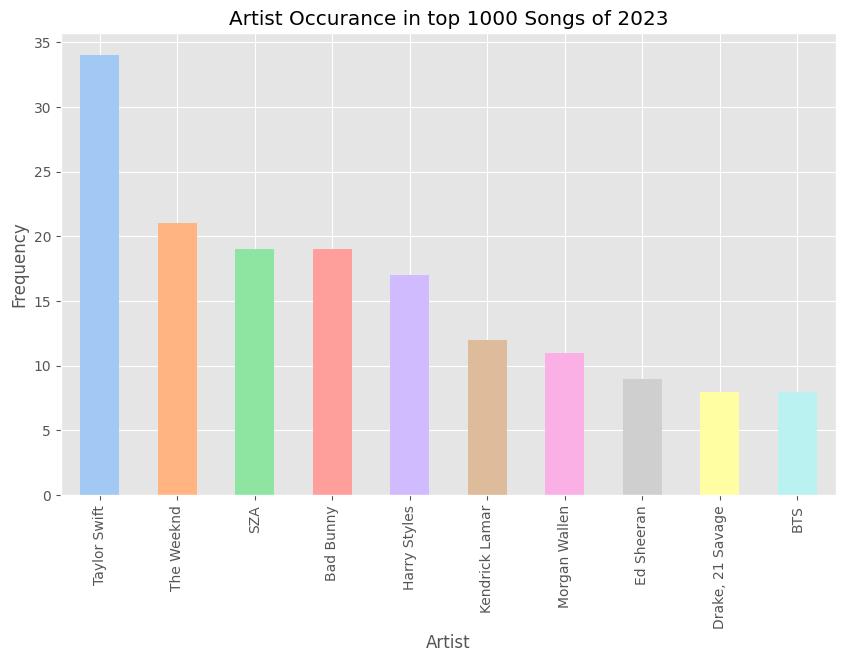
Release Year
songs_by_year = df['released_year'].value_counts().reset_index()
songs_by_year.columns = ['released_year', 'count']
plt.figure(figsize=(10, 6))
sns.barplot(x='released_year', y='count', data=songs_by_year.head(15), palette='PuRd',hue='released_year', legend=False)
plt.title('Number of Songs by Release Year')
plt.xlabel('Release Year')
plt.ylabel('Number of Songs')
plt.show()
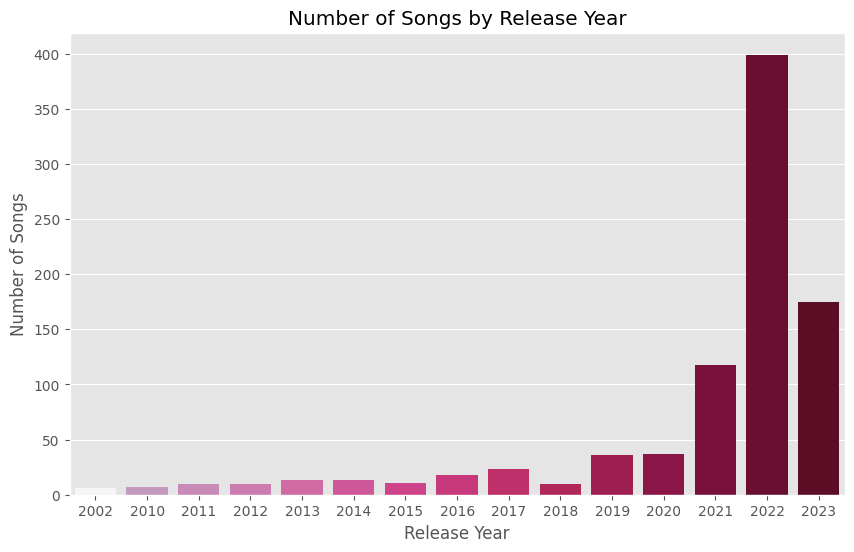
BPM Distribution
plt.figure(figsize=(10, 6))
df['bpm'].hist(color='gray',bins=12)
plt.xlabel("BPM")
plt.ylabel("Frequency")
plt.title('Song BPM Distribution')
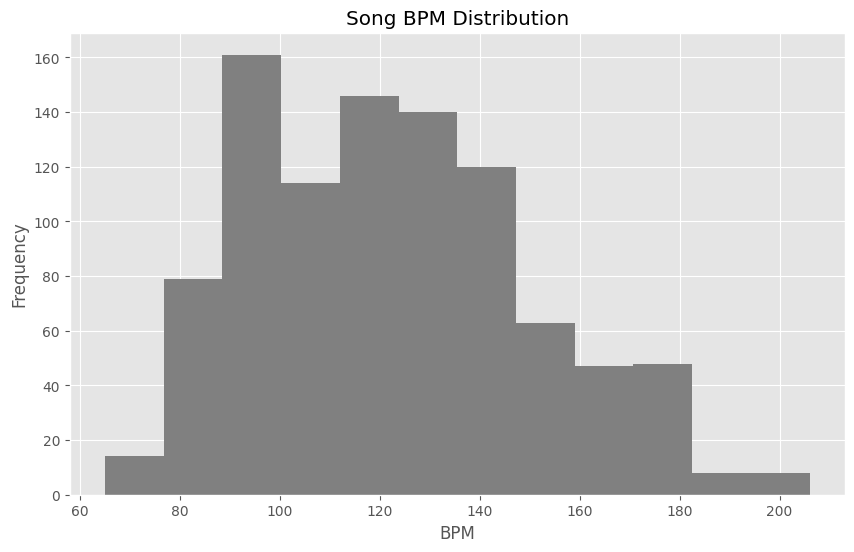
Pair Plot of Attributes
df_attribute = df[['danceability_%','valence_%','energy_%','acousticness_%','instrumentalness_%','liveness_%','speechiness_%']]
plt.figure(figsize=(9, 9))
sns.set_style("white")
plt.style.use(['ggplot'])
sns.pairplot(df_attribute, height=1.5)
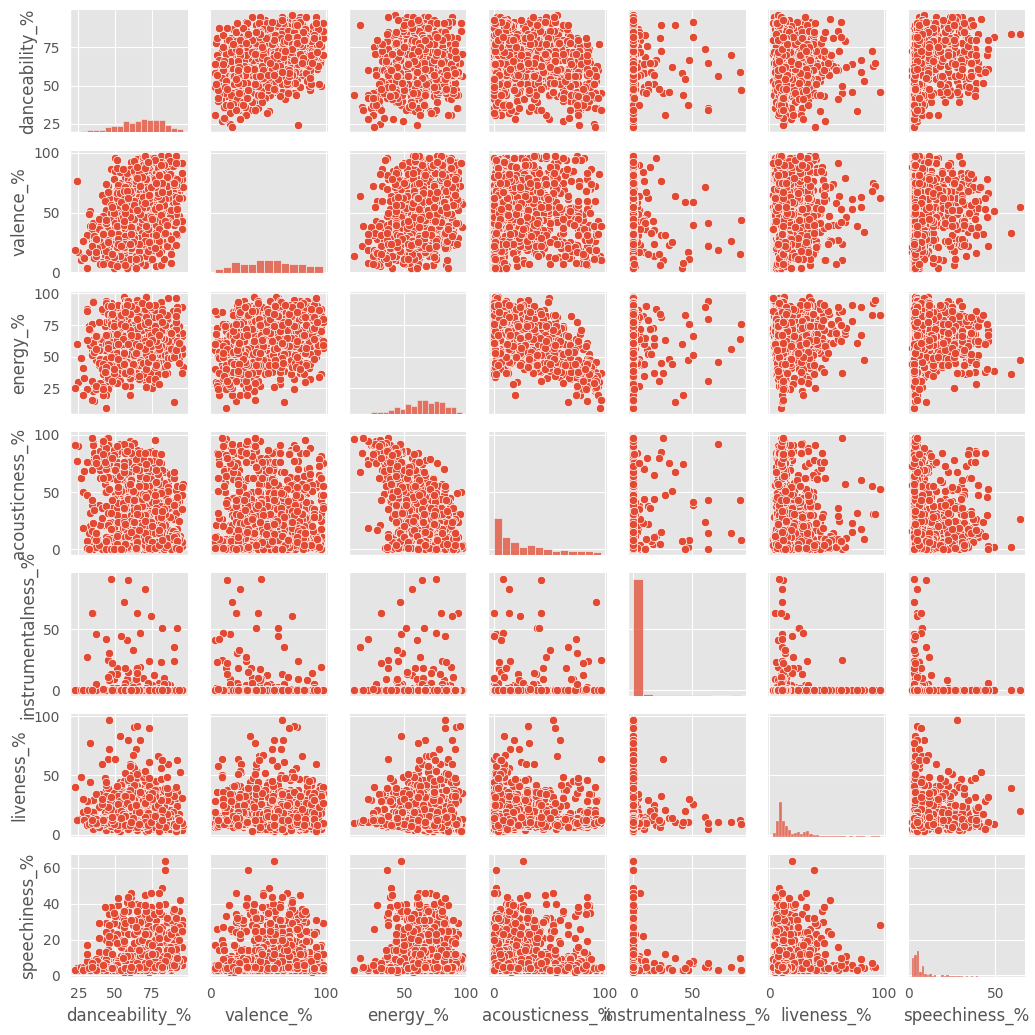
We can see that there really isn’t much of a linear correlation between these variables. In fact, many don’t show any correlation. Let’s look at a heat map to better visualize this.
Correlation Heatmap
numeric_df = df.select_dtypes(include=['float64', 'int64'])
# Calculate the correlation matrix
correlation_matrix = numeric_df.corr()
# Plot the correlation matrix using Seaborn
plt.figure(figsize=(10, 10))
sns.heatmap(correlation_matrix, annot=True, cmap='coolwarm', fmt=".2f")
plt.title('Correlation Matrix')
plt.show()
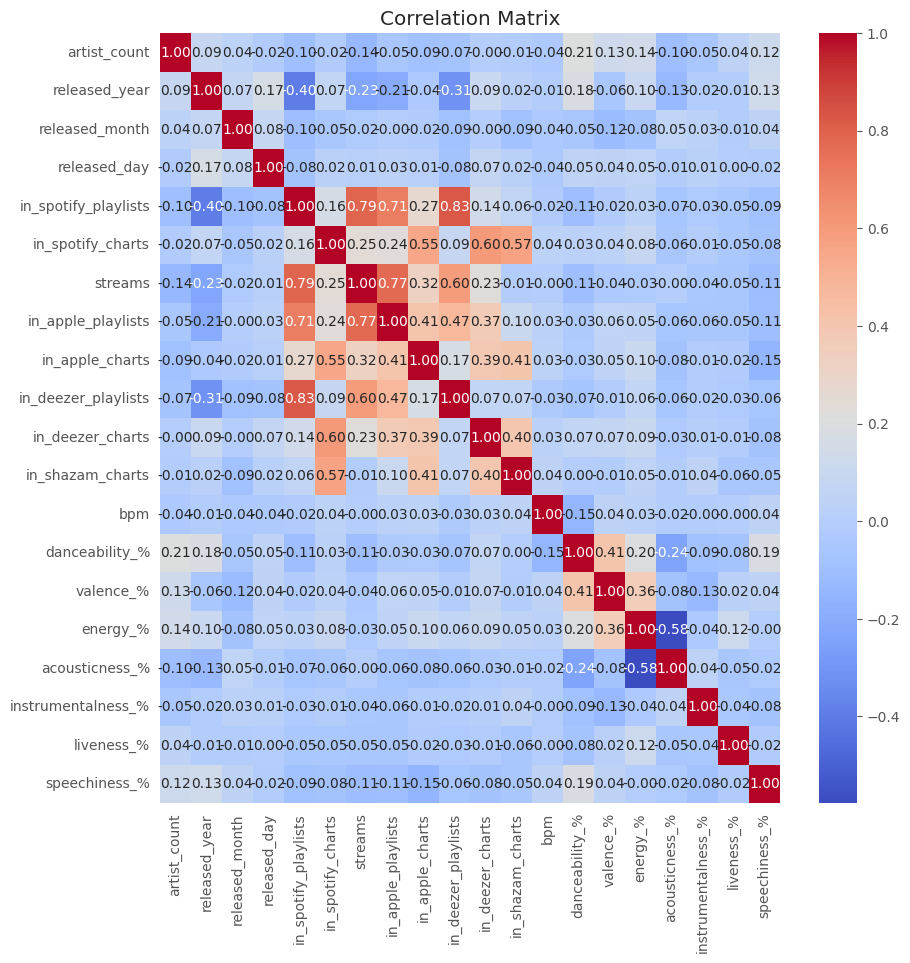
As expected. The attributes we looked at in the pair pot don’t have much of a correlation, except for the decent negative correlation in energy and acousticness, which we expected to see.
Now we have a good idea of what our data is like. We can now move on to machine learning.
Preparing for Machine Learning
Before we move on to machine learning, we have to look deeper into the variable we will be using. We will be using a clustering algorithm, meaning that there are no labels to worry about. With that being said, there is still an issue with categorical and numeric data. We observe that month is denoted with a numeric value. This does not really make any sense as a numeric value, and works better as a categorical variable. Let’s make this change.
def month_number_to_name(month_number):
months = [
None,
"January", "February", "March", "April",
"May", "June", "July", "August",
"September", "October", "November", "December"
]
if month_number < 1 or month_number > 12:
return "Invalid month number"
return months[month_number]
df['released_month'] = df['released_month'].astype(object)
df.released_month = df.released_month.apply(lambda x: month_number_to_name(x))
Before we run this on the machine learning model, we will have to encode catagorical variables.
dummies = pd.get_dummies(df['mode'],prefix="mode")
df_encode = pd.concat([df, dummies], axis=1)
dummies = pd.get_dummies(df['released_month'],prefix="released_month")
df_encode = pd.concat([df_encode, dummies], axis=1)
df_encode.drop(columns=["released_month","mode","artist(s)_name","track_name"], inplace=True)
df_encode.info()
Int64Index: 948 entries, 0 to 952
Data columns (total 33 columns):
# Column Non-Null Count Dtype
--- ------ -------------- -----
0 artist_count 948 non-null int64
1 released_year 948 non-null int64
2 released_day 948 non-null int64
3 in_spotify_playlists 948 non-null int64
4 in_spotify_charts 948 non-null int64
5 streams 948 non-null int64
6 in_apple_playlists 948 non-null int64
7 in_apple_charts 948 non-null int64
8 in_deezer_playlists 948 non-null int64
9 in_deezer_charts 948 non-null int64
10 in_shazam_charts 948 non-null int64
11 bpm 948 non-null int64
12 danceability_% 948 non-null int64
13 valence_% 948 non-null int64
14 energy_% 948 non-null int64
15 acousticness_% 948 non-null int64
16 instrumentalness_% 948 non-null int64
17 liveness_% 948 non-null int64
18 speechiness_% 948 non-null int64
19 mode_Major 948 non-null uint8
20 mode_Minor 948 non-null uint8
21 released_month_April 948 non-null uint8
22 released_month_August 948 non-null uint8
23 released_month_December 948 non-null uint8
24 released_month_February 948 non-null uint8
25 released_month_January 948 non-null uint8
26 released_month_July 948 non-null uint8
27 released_month_June 948 non-null uint8
28 released_month_March 948 non-null uint8
29 released_month_May 948 non-null uint8
30 released_month_November 948 non-null uint8
31 released_month_October 948 non-null uint8
32 released_month_September 948 non-null uint8
dtypes: int64(19), uint8(14)
memory usage: 161.1 KB
We can see that columns are numeric. We are now ready to train our model.
K-means Clustering
Clustering algorithms are a type of unsupervised learning algorithm that focuses on grouping similar data points. We discussed a bit on clustering last week, so look back to that for a refesher. As mentioned last week, there are many types of clustering algorithms. For this project, we will focus on a rather popular clustering algorithm called, K-Means Clustering.
We will utilize this clustering algorithms to group songs into clusters. Based on the listener’s last played song, we will look at similar songs (songs in the same cluster) to recommend other songs.
If you want to know more about other clustering algorithms, I recommend looking into it yourself; there’s a ton to learn!
First, let’s go over K-Means Clustering.
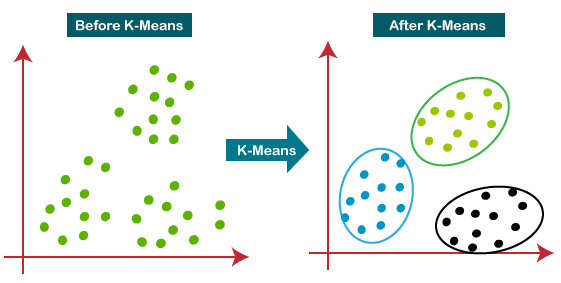
Explaining the Algorithm
In a broad view, the algorithm searches for a predetermined number of clusters within unlabeled data. It considers optimal clustering to have the following properties:
- The cluster center is the arithmetic mean of all the points belonging to the cluster.
- Each point is closer to its own cluster center than other cluster centers.
With this in mind, let’s see how we can make an algorithm to achieve optimal clustering.
Expectation-Maximization
E-M is a powerful general algorithm that appears throughout ML and data science applications. In essence, this algorithm revolves around updating expectations and maximizing some fitness function, which defines the locations of cluster centers. Here is the general procedure for K-means:
- Guess some random cluster centers
- Repeat the following until convergence:
- E-step: assign points to the nearest cluster; update expectationbs of which cluster each point belongs to
- M-step: Move the cluster centers to the center of each cluster, which is the simple mean of the data in each cluster

Note that E-M only guarentees to improve the result in each step, but there is no assurance that it will lead to the global best solution. Basically, depending on the starting result, we might improve on an overall worse solution than to what we had previously.
This algorithm is relatively simple, so let’s go ahead and code it!
For this example, we need a dataset of clusters.
#@title Create Clusters Data
import numpy as np
from sklearn.datasets import make_blobs
np.random.seed(31)
# Parameters
num_samples = 500 # Total number of data points
num_clusters = 5 # Number of clusters
cluster_std = 0.9 # Standard deviation of clusters
# Generate random clusters
X, y = make_blobs(n_samples=num_samples, centers=num_clusters, cluster_std=cluster_std)
# Create 2D numpy array with random data points
data = np.column_stack((X[:, 0], X[:, 1]))
Let’s see what points were randomly generated:
plt.scatter(data[:,0],X[:,1])
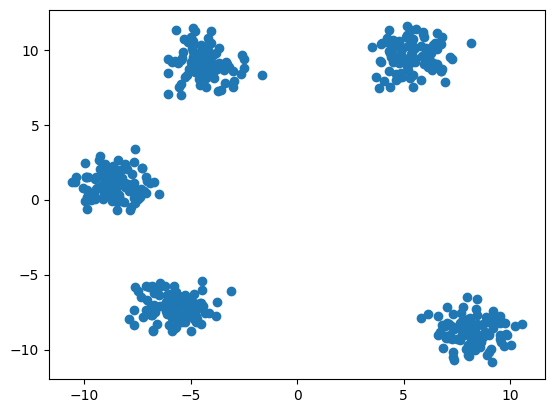
Finally, let’s code the K-means algorithm using the E-M algorithm we reviewed:
from sklearn.metrics import pairwise_distances_argmin
def find_clusters(X, n_clusters, rseed=100): # Function
# Step 1. Randomly choose cluster centers
epochs=0
rng = np.random.RandomState(rseed)
i = rng.permutation(X.shape[0])[:n_clusters]
centers = X[i]
while True:
epochs += 1
#2a. E-step: Assign labels based on closest center
labels = pairwise_distances_argmin(X,centers)
#2b. M-step: Find new centers from means of points in clusters
new_centers = np.array([X[labels == i].mean(0)
for i in range(n_clusters)])
#2c. Check for Convergence to end
if np.all(centers == new_centers):
print("k-means converged at " + str(epochs) + " steps")
break
else:
centers = new_centers
return centers, labels
Code adapted from Python Data Science Handbook (2017)
Now that we made our model, all we need to do now is call it!.
centers, labels = find_clusters(data, 5, 68) #Hyperparameters: number of clusters, random seed
plt.scatter(data[:,0],data[:,1], c=labels, s=50, cmap='viridis')
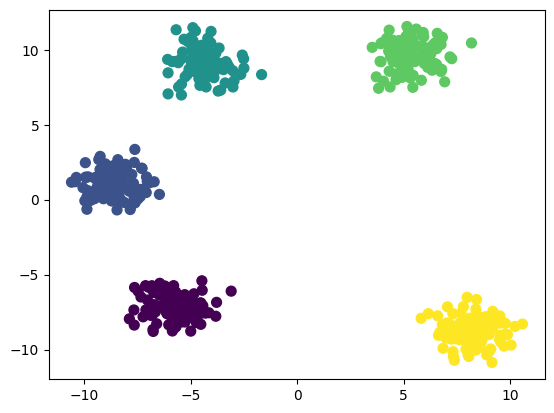
Keep in mind that this model is sensitive to its initial conditions, leading to some models being extremely different from others depending on it’s initial state. Additionally, k-means is limited to linear cluster boundaries, meaning that it will often fail for more complicated cluster boundaries.
centers, labels = find_clusters(data, 5, 32) # Changed the random state
plt.scatter(data[:,0],data[:,1], c=labels, s=50, cmap='viridis')
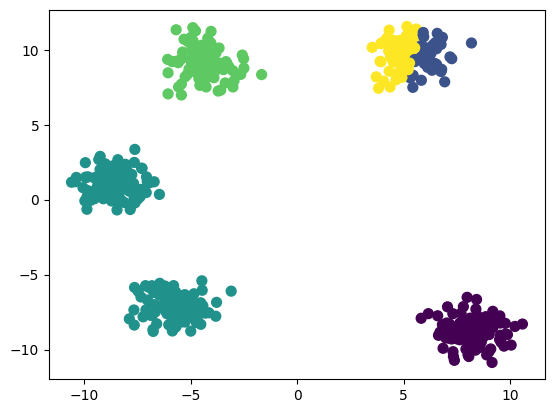
As you can see, this performed a lot worse than the last model.
We are using k-means in this project due to its simplicity and speed. Ideally, we would be using a different clustering algorithm, but for the sake of demonstration, we will stick to k-means.
With all that explanation done, let’s hop back to our Spotify data!
Training Model
Clusters - Find the optimal number of clusters
from sklearn.preprocessing import StandardScaler
from sklearn.cluster import KMeans
from sklearn.decomposition import PCA
from sklearn.preprocessing import StandardScaler
scaler = StandardScaler()
df_encode_scaled = scaler.fit_transform(df_encode)
df_encode_scaled.shape
(948, 20)
Within-Cluster Sum of Square (WCSS) - the sum of the square distance between points in a cluster and the cluster center.
To find the optimal value of clusters, the elbow method follows the below steps:
- It executes the K-means clustering on a given dataset for different K values (ranges from 1-60).
- For each value of K, calculates the WCSS value.
- Plots a curve between calculated WCSS values and the number of clusters K.
- The sharp point of bend or a point of the plot looks like an arm, then that point is considered as the best value of K.
score_1 = []
range_values = range(1, 60)
for i in range_values:
kmeans = KMeans(n_clusters = i, n_init = "auto")
kmeans.fit(df_encode_scaled)
score_1.append(kmeans.inertia_)
plt.plot(score_1, 'bx-')
plt.title('WCSS vs. Number of Clusters')
plt.xlabel('Number of Clusters')
plt.ylabel('WCSS Score')
plt.show()
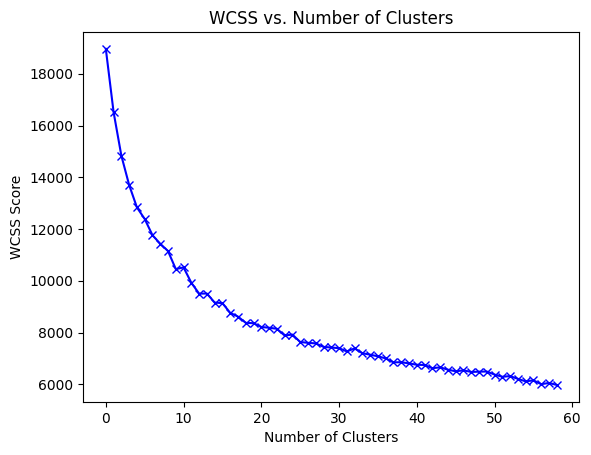
The bend looks to occur around 16 - 20 clusters. Let’s go with 16.
Now, lets train a k-Means model with 16 clusters and our data.
Using K-Means Now we call KMeans and input the desired hyperparameters. For the meaning of each hyperparameter, please refer to the scikit-learn documentation.
kmeans = KMeans(n_clusters = 16, init = 'k-means++', max_iter = 400, n_init = 10, random_state = 9)
labels = kmeans.fit_predict(df_encode_scaled)
Let’s add the cluster labels back to our original dataframe
df_cluster = pd.concat([df, pd.DataFrame({'cluster': labels})], axis = 1)
Check and remove any null values
df_cluster.dropna(axis=0,inplace=True)
df_cluster.shape
(943,24)
To get a better picture of our clusters, let’s create some visualizations!
Visualization using PCA
We obviously can’t see in 20 dimensions, so we have to reduce these dimensions in order to visualize. So, let’s use PCA! (For more info about PCA and dimensionality reduction, refer to this article)
Compress data to two input variables. This will allow us to view the clusters in two dimensions.
pca = PCA(n_components = 2)
principal_comp = pca.fit_transform(df_encode_scaled)
pca_df = pd.DataFrame(data = principal_comp, columns = ['pca1', 'pca2'])
We just reduced our dimensions to just two dimensions, so now we can easily visualize the data in a scatter plot.
Visualize clustering
pca_df = pd.concat([pca_df, pd.DataFrame({'cluster': labels})], axis = 1)
import seaborn as sns
plt.figure(figsize = (10, 10))
c = sns.color_palette(palette='tab20')
ax = sns.scatterplot(x = 'pca1', y = 'pca2', hue = 'cluster', data = pca_df, palette = c)
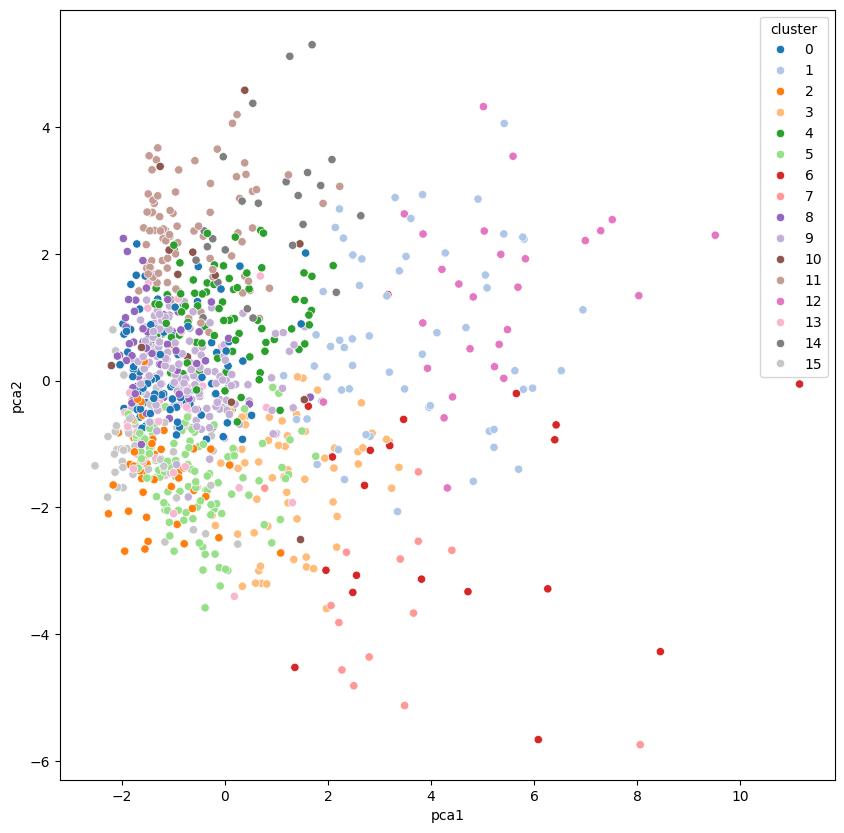
We can even visualize this in 3D!
pca = PCA(n_components = 3)
principal_comp = pca.fit_transform(df_encode_scaled)
pca3d_df = pd.DataFrame(data = principal_comp, columns = ['pca1', 'pca2', 'pca3'])
pca3d_df = pd.concat([pca3d_df, pd.DataFrame({'cluster': labels})], axis = 1)
pca3d_df["cluster"] = pca3d_df["cluster"].astype(str)
import plotly.express as px
df = px.data.iris()
fig = px.scatter_3d(pca3d_df, x = 'pca1', y = 'pca2', z='pca3',
color='cluster',color_discrete_sequence=px.colors.qualitative.Alphabet)
fig.update_layout(margin=dict(l=0, r=0, b=0, t=0))
fig.show()
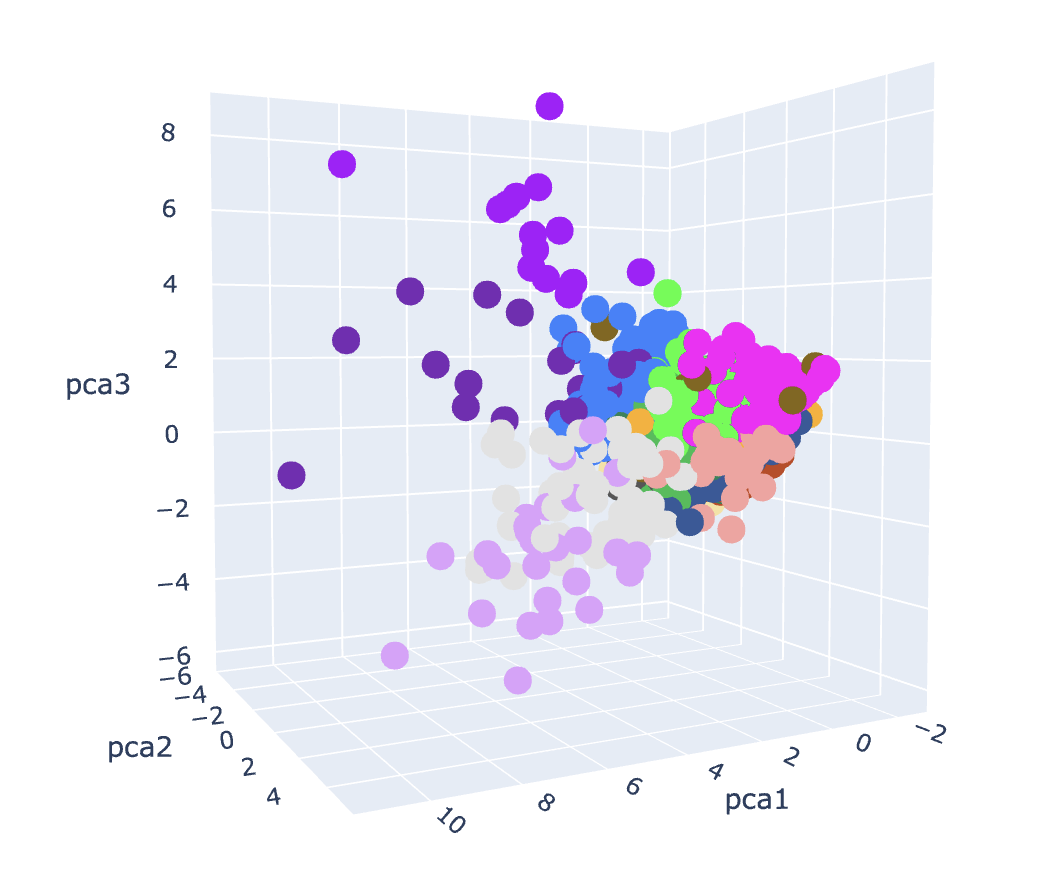
From where we see the distribution of the data points, there is no clear grouping of clusters, but th K-means model found the clusters that it output. To get more insight into the clusters, let’s look at them directly.
Examining Clusters
Let’s take a look at a distribution of the data
df_reduced = df_cluster.drop(columns=['track_name','artist(s)_name','released_month'])
# Each row of figures represents feature distribution for each cluster
for i in df_reduced.columns:
plt.figure(figsize = (48, 5))
for j in range(16):
plt.subplot(1, 16, j+1)
cluster = df_reduced[ df_reduced['cluster'] == j ]
cluster[i].hist(bins = 20)
plt.title( '{}\nCluster {}'.format(i, j))
plt.show()

Your Turn! Making Recommendations
To make recommendations, we need to implement the following:
- The user must input a valid track name and artist of their last played song
- The program searches the dataset for this song and artist and retrieves the cluster associated with this particular track.
- The program retrieves only the track titles and artist names of other songs within this cluster and prints it to user.
If the user inputs track name “vampire” and artist “Olivia Rodrigo”, the output should be all the songs which share the same cluster! Here’s some example code to give you some hints
# User inputs 'vampire' by 'Olivia Rodrigo'
condition = (df_cluster['track_name']=='vampire') & (df_cluster['artist(s)_name']=='Olivia Rodrigo')
desired_cluster = df_cluster[condition].cluster.to_numpy()[0]
# Output songs in the same cluster
df_cluster[df_cluster['cluster'] == desired_cluster][['track_name','artist(s)_name']]
| track_name | artist(s)_name |
|---|---|
| Seven (feat. Latto) (Explicit Ver.) | Latto, Jung Kook |
| vampire | Olivia Rodrigo |
| Cruel Summer | Taylor Swift |
| Sprinter | Dave, Central Cee |
| fukumean | Gunna |
| Flowers | Miley Cyrus |
| Daylight | David Kushner |
| What Was I Made For? [From The Motion Picture … | Billie Eilish |
| Popular (with Playboi Carti & Madonna) - The I… | The Weeknd, Madonna, Playboi Carti |
| Barbie World (with Aqua) [From Barbie The Album] | Nicki Minaj, Aqua, Ice Spice |
| Baby Don’t Hurt Me | David Guetta, Anne-Marie, Coi Leray |
| Makeba | Jain |
| MONTAGEM - FR PUNK | Ayparia, unxbected |
| Tattoo | Loreen |
And with that you have made a spotify recommendation algorithm! Congratulations!